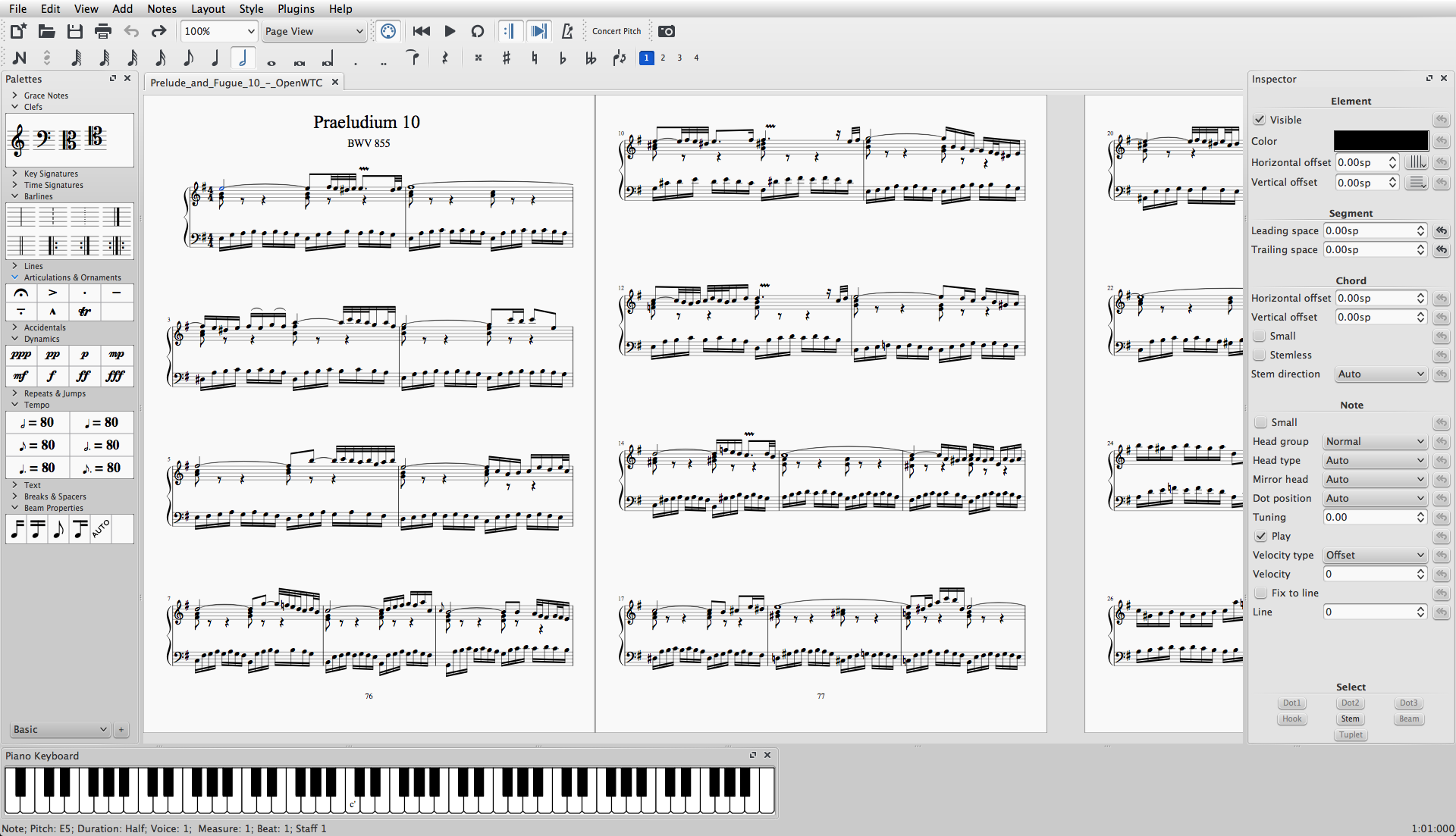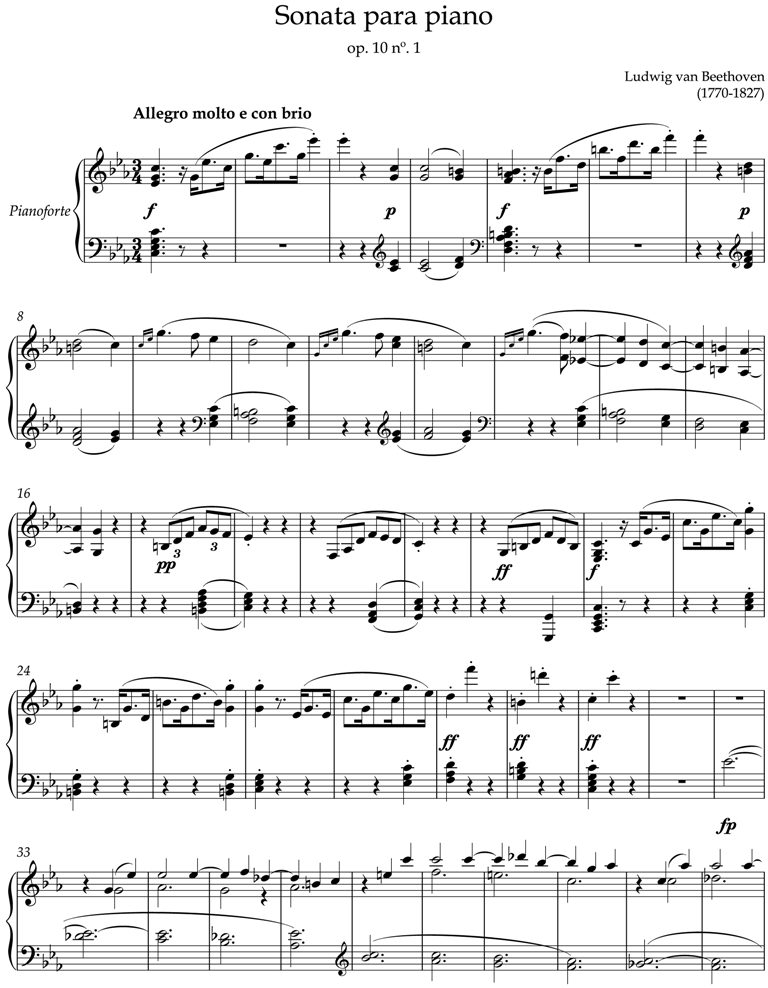|
Scorewriters
A scorewriter, or music notation program is software for creating, editing and printing sheet music. A scorewriter is to music notation what a word processor is to text, in that they typically provide flexible editing and automatic layout, and produce high-quality printed results. Most scorewriters, especially those from the 2000s, can record notes played on a MIDI keyboard (or other MIDI instruments), and play music back via MIDI or virtual instruments. Playback is especially useful for novice composers and music students, and when musicians are not available or affordable. Several free programs are widely used, such as MuseScore. The three main professional-level programs are Finale, Sibelius and Dorico. Comparison with multitrack sequencer software Multitrack sequencer software and scorewriters typically employ different methods for notation input and display. Scorewriters are based on traditional music notation, using staff lines and round note heads, which originates f ... [...More Info...] [...Related Items...] OR: [Wikipedia] [Google] [Baidu] |
Capella (notation Program)
capella is a musical notation program or scorewriter developed by the German company ''Capella Software AG'' (formerly WHC), running on Microsoft Windows or corresponding emulators in other operating systems, like Wine (software), Wine on Linux and others on Macintosh, Apple Macintosh. Capella requires to be Product activation, activated after a trial period of 30 days. The publisher writes the name in lower case letters only. The program was initially created by Hartmut Ring, and is now maintained and developed by Bernd Jungmann. Capella is one of the earliest computer programs for music notation and has a relatively moderate price compared with Finale (software), Finale or Sibelius (software), Sibelius, though up to version 7 it ran only on Windows. Capella claims to have 300,000 users for the music notation program and 120,000 for the OCR program. Digital sheet music in capella formats is available in various online music libraries, especially in German speaking areas. The Ger ... [...More Info...] [...Related Items...] OR: [Wikipedia] [Google] [Baidu] |
SCORE (software)
SCORE is a scorewriter program, written in FORTRAN for MS-DOS by Stanford University Professor Leland Smith (1925–2013) with a reputation for producing very high-quality results. It was widely used in engraving (music), engraving during the 1980s and 1990s and continues to have a small, dedicated following of engravers, many of whom hold the program in high regard due to its ability to position symbols precisely on the page. Several publications set using SCORE have earned Paul Revere and German Musikpresse engraving awards. Program development Mainframe origins The first incarnation of SCORE was written by Leland Smith in 1967 as a means of entering music into the MUSIC V sound generating system running on the PDP-10 mainframe computers at the Stanford Artificial Intelligence Laboratory (SAIL). The core concept of SCORE was to break music into a set of items ('objects' in modern terminology) with parameters that describe their characteristics. In this example of an early SCO ... [...More Info...] [...Related Items...] OR: [Wikipedia] [Google] [Baidu] |
Dorico
Dorico () is a scorewriter software; along with Finale (software), Finale and Sibelius (scorewriter), Sibelius, it is one of the three leading professional-level music notation programs. Dorico's development team consists of most of the former core developers of a rival software, Sibelius (scorewriter), Sibelius. After the developers of Sibelius (scorewriter), Sibelius were laid off in a 2012 restructuring by their corporate owner, Avid Technology, Avid, most of the team were re-hired by a competing company, Steinberg, to create a new software. They aimed to build a "next-generation" music notation program, and released Dorico four years later, in 2016. History The project was unveiled on 20 February 2013 by the Product Marketing Manager, Daniel Spreadbury, on the blog ''Making Notes'', and the software was first released on 19 October 2016. The program's title ''Dorico'' was revealed on the same blog on 17 May 2016. The name honours the 16th-century Italian music engraver V ... [...More Info...] [...Related Items...] OR: [Wikipedia] [Google] [Baidu] |
Music Engraving
Music engraving is the art of drawing music notation at high quality for the purpose of mechanical reproduction. The term ''music copying'' is almost equivalent—though ''music engraving'' implies a higher degree of skill and quality, usually for publication. The name of the process originates in plate engraving, a widely used technique dating from the late sixteenth century. The term ''engraving'' is now used to refer to any high-quality method of drawing music notation, particularly on a computer ("computer engraving" or "computer setting") or by hand ("hand engraving"). Traditional engraving techniques Elements of music engraving style Mechanical music engraving began in the middle of the fifteenth century. As musical composition increased in complexity, so too did the technology required to produce accurate musical scores. Unlike literary printing, which mainly contains printed words, music engraving communicates several different types of information simultaneously. T ... [...More Info...] [...Related Items...] OR: [Wikipedia] [Google] [Baidu] |
Sibelius (scorewriter)
Sibelius is a scorewriter program developed and released by Sibelius Software Limited (now part of Avid Technology). It is the world's largest selling music notation program. Beyond creating, editing and printing music scores, Sibelius can also play the music back using sampled or synthesised sounds. It produces printed scores, and can also publish them via the Internet for others to access. Less advanced versions of Sibelius at lower prices have been released, as have various add-ons for the software. Named after the Finnish composer Jean Sibelius, the company was founded in April 1993 by twin brothers Ben and Jonathan Finn to market the eponymous music notation program they had created. It went on to develop and distribute various other music software products, particularly for education. In addition to its head office in Cambridge and subsequently London, Sibelius Software opened offices in the US, Australia and Japan, with distributors and dealers in many other coun ... [...More Info...] [...Related Items...] OR: [Wikipedia] [Google] [Baidu] |
Finale (software)
Finale is a proprietary music notation software developed and released by MakeMusic for Microsoft Windows and macOS since 1988. Functionality Finale's tools are organized into multiple hierarchically organized palettes, and the corresponding tool must be selected to add or edit any particular class of score element. Voices are available in Finale as well. Several of Finale's tools provide an associated menu just to the left of the Help menu, available only when that particular tool is selected. In general, operation of Finale bears at least some surface similarities to Adobe Photoshop. On the screen, Finale provides the ability to color code several elements of the score as a visual aid; on the print-out all score elements are black (unless color print-out is explicitly chosen). With the corresponding tool selected, fine adjustment of each set of objects in a score are possible either by clicking and dragging or by entering measurements in a dialog box. A more generalized sele ... [...More Info...] [...Related Items...] OR: [Wikipedia] [Google] [Baidu] |
Digital Audio Workstation
A digital audio workstation (DAW) is an electronic device or application software used for Sound recording and reproduction, recording, editing and producing audio files. DAWs come in a wide variety of configurations from a single software program on a laptop, to an integrated stand-alone unit, all the way to a highly complex configuration of numerous components controlled by a central computer. Regardless of configuration, modern DAWs have a central interface that allows the user to alter and mix multiple recordings and tracks into a final produced piece. DAWs are used for producing and recording music, songs, human speech, speech, Radio broadcasting, radio, television, soundtracks, podcasts, sound effects and nearly any other situation where complex recorded audio is needed. Hardware Early attempts at digital audio workstations in the 1970s and 1980s faced limitations such as the high price of storage, and the vastly slower processing and disk speeds of the time. In 1978, ... [...More Info...] [...Related Items...] OR: [Wikipedia] [Google] [Baidu] |
Musical Keyboard
A musical keyboard is the set of adjacent depressible levers or keys on a musical instrument. Keyboards typically contain keys for playing the twelve notes of the Western musical scale, with a combination of larger, longer keys and smaller, shorter keys that repeats at the interval of an octave. Pressing a key on the keyboard makes the instrument produce sounds—either by mechanically striking a string or tine ( acoustic and electric piano, clavichord), plucking a string ( harpsichord), causing air to flow through a pipe organ, striking a bell (carillon), or, on electric and electronic keyboards, completing a circuit (Hammond organ, digital piano, synthesizer). Since the most commonly encountered keyboard instrument is the piano, the keyboard layout is often referred to as the ''piano keyboard''. Description The twelve notes of the Western musical scale are laid out with the lowest note on the left. The longer keys (for the seven "natural" notes of the C major scale: C, D, E ... [...More Info...] [...Related Items...] OR: [Wikipedia] [Google] [Baidu] |
List Of Scorewriters
A ''list'' is any set of items in a row. List or lists may also refer to: People * List (surname) Organizations * List College, an undergraduate division of the Jewish Theological Seminary of America * SC Germania List, German rugby union club Other uses * Angle of list, the leaning to either port or starboard of a ship * List (information), an ordered collection of pieces of information ** List (abstract data type), a method to organize data in computer science * List on Sylt, previously called List, the northernmost village in Germany, on the island of Sylt * ''List'', an alternative term for ''roll'' in flight dynamics * To ''list'' a building, etc., in the UK it means to designate it a listed building that may not be altered without permission * Lists (jousting), the barriers used to designate the tournament area where medieval knights jousted * ''The Book of Lists'', an American series of books with unusual lists See also * The List (other) * Listing (di ... [...More Info...] [...Related Items...] OR: [Wikipedia] [Google] [Baidu] |
Graphic Notation (music)
Graphic notation (or graphic score) is the representation of music through the use of visual symbols outside the realm of traditional music notation. Graphic notation became popular in the 1950s, and can be used either in combination with or instead of traditional music notation.Pryer, Anthony. "Graphic Notation." ''The Oxford Companion to Music'', edited by Alison Latham. ''Oxford Music Online''. 12 April 2011 Graphic notation was influenced by contemporary visual art trends in its conception, bringing stylistic components from modern art into music. Composers often rely on graphic notation in experimental music, where standard musical notation can be ineffective. Other uses include pieces where an Aleatoric music, aleatoric or Indeterminacy (music), undetermined effect is desired. One of the earliest pioneers of this technique was Earle Brown, who, along with John Cage, sought to liberate performers from the constraints of notation and make them active participants in the creation ... [...More Info...] [...Related Items...] OR: [Wikipedia] [Google] [Baidu] |
Steinberg
Steinberg Media Technologies GmbH (trading as Steinberg) is a German musical software and hardware company based in Hamburg. It develops music writing, recording, arranging, and editing software, most notably Cubase, Nuendo, and Dorico. It also designs audio and MIDI hardware interfaces, controllers, and iOS/ Android music apps including Cubasis. Steinberg created several industry standard music technologies including the Virtual Studio Technology (VST) format for plug-ins and the ASIO (Audio Stream Input/Output) protocol. Steinberg has been a wholly owned subsidiary of Yamaha since 2005. History The company was founded in 1984 by Karl Steinberg and Manfred Rürup in Hamburg. As early proponents and fans of the MIDI protocol, the two developed Pro 16, a MIDI sequencing application for the Commodore 64 and soon afterwards, Pro 24 for the Atari ST platform. The ST had built-in MIDI ports which helped to quickly increase interest in the new technology across the music world. In ... [...More Info...] [...Related Items...] OR: [Wikipedia] [Google] [Baidu] |





